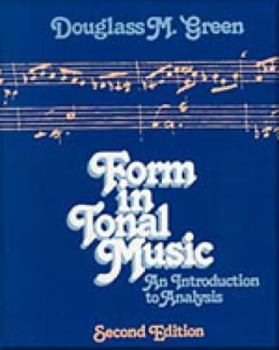Form in Tonal Music: An Introduction to Analysis
Select Format
Select Condition 
Book Overview
Like many texts on musical analysis, FORMS IN TONAL MUSIC equips students to critically examine a wide range of compositions and forms. However, Green's text takes students a step further by enabling... This description may be from another edition of this product.
Format:Hardcover
Language:English
ISBN:0030202868
ISBN13:9780030202865
Release Date:April 1979
Publisher:Cengage Learning
Length:336 Pages
Weight:1.60 lbs.
Dimensions:0.7" x 7.7" x 9.6"
Customer Reviews
3 ratings
A fine text to help students develop skills in analysis of tonal music
Published by Thriftbooks.com User , 18 years ago
This is not a book on form in the old sense of the term. That is, it is not a collection of terms for students to use as decals to stick on pieces as they learn them. Green aims to provide the student with skills that aid him or her to understand what the piece is about. What is that the piece says about itself? This is important because every piece, especially the masterworks, takes its own approach to form and for every rule provided, you can find many exceptions. The problem with the label approach is that music, thankfully, is not so standardized that you can say for a certainty how a given piece of a certain type is going to behave. Yes, Green does use the standard terms, but only as a means of generalization. He is very good at pointing out the range of behaviors one might expect within a given form. He also provides historical notes that discuss how certain composers or historical periods used certain materials in their compositions. Again, the goal here is to help students to develop a set of tools and intuitions so he or she can look at any (tonal) piece of music and be able to analyze what is going on within the piece. The labels only help the student if they allow the student to look more deeply and directly at the music. However, if the analysis stops with the application of a label the student will actually have been harmed. Remember, most labels are developed after a sufficient body of music has been written to codify a form. So, the living composers often wrote the music without the benefit of the terms we often use to describe their work. While the book has many fine musical examples and recommended exercises, the teacher may wish to supplement them with examples of her own in order to provide supplementary examples of the principles discussed in the text. I believe the student gets a better idea of how music works through multiple and varied examples from the literature. The more well-chosen examples the student hears the better.
highly informative, but leaving a few gaps
Published by Thriftbooks.com User , 19 years ago
This book is jam-packed with facts. I have just two major criticisms: --The explanations on binary forms is unnecessarily difficult to understand. Just in case you're wondering, a binary form is closed, or sectional, if the first half ends on the tonic. It is open, or continuous, if the first half ends on the dominant or any other chord. It is rounded if the second part ends with a restatement of the first part. It is simple if the second part does not end with such a restatement. That is all in the wide world there is to it! --The book gives detailed analyses of compositions after offering few or no musical examples. (I should have read Annie Burridge's review and purchased the Burkhart Anthology.) I also see a few high points which are missed: --There is no discussion of development themes. An outstanding example is Mendelssohn's Italian Symphony. --There is no discussion of development canons. An outstanding example is Franck's Symphony in d minor. --In the discussion on chorale preludes, he doesn't give the familiar example of "Wachet Auf." --In the discussion on vocal chorales, he doesn't give the familiar example of "Jesu, Joy of Man's Desiring." --In the discussion on baroque partitas, I would like to see the characteristic rhythms of each of the dance movements. The author probably considers this outside the scope of the book. --He tells us that the recapitulation does not always treat all the themes in the exposition, but he gives us few examples. I have wondered why we never hear the lyrical theme in the recapitulation of the Dvorak cello concerto. This is such a well-known composition that I think it should be used as an example. --I'm curious about how the Liszt piano concertos are constructed. --I'm also curious about how the megalomanic symphonies by Mahler and Bruckner are constructed. It seems that the author was partial toward music of the baroque and classical eras, but nineteenth-century music is popular, like it or not. --I would like more discussion about keyboard preludes. I have never been able to compose a good keyboard prelude. --There is no discussion of standard liturgical texts for church vocal music. The author probably considered this outside the scope of the book, also.
used this text in undergrad GREAT!
Published by Thriftbooks.com User , 24 years ago
I used this text in my undergradaute study of music and find it to be useful even today. Greens' explanations along with exerpts and examples makes form in music an interesting facet. It is for those who are ready to dive into form and analysis head first. I would not recommend it to a beginner with little or no hard-core theory knowledge.






